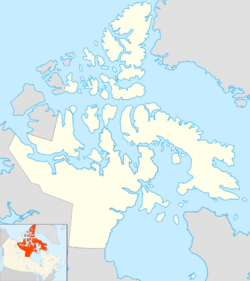Martin Islands facts for kids
| Geography | |
|---|---|
| Location | Gulf of Boothia |
| Coordinates | 70°14′N 91°30′W / 70.233°N 91.500°W |
| Archipelago | Canadian Arctic Archipelago |
| Administration | |
| Territory | Nunavut |
| Region | Kitikmeot |
| Demographics | |
| Population | Uninhabited |
The Martin Islands are a group of islands located in the far north of Canada. They are part of the Canadian Arctic Archipelago, a huge collection of islands in the Arctic Ocean. These islands are found within the territory of Nunavut, which is Canada's largest and newest territory.
The Martin Islands are specifically located in the western part of the Gulf of Boothia. This gulf is a large body of water that connects to the Arctic Ocean. The islands are also quite close to the Boothia Peninsula, which is the northernmost point of mainland North America. Because of their location, the Martin Islands are uninhabited, meaning no people live there permanently.
Contents
Exploring the Arctic Location
The Martin Islands are situated in a very remote and cold part of the world. The Canadian Arctic Archipelago is made up of thousands of islands. Many of these islands are covered in ice and snow for most of the year. The Gulf of Boothia, where the Martin Islands are found, is often frozen over. This makes travel to and from the islands very difficult.
Climate of the Arctic Islands
The climate around the Martin Islands is known as a polar climate. This means it is extremely cold for most of the year. Winters are long and dark, with temperatures often dropping far below freezing. Summers are very short and cool. Even in summer, the ice in the gulf might not fully melt. This harsh environment shapes what kind of life can survive there.
Geography of the Region
The landforms around the Martin Islands are typical of the Arctic. You would find rocky coastlines and low-lying areas. The landscape is often shaped by glaciers from past ice ages. These glaciers carved out valleys and left behind many lakes and rivers. The Boothia Peninsula, nearby, is also a rugged and icy land.
Wildlife of the Martin Islands and Surrounding Areas
Even though the Martin Islands are uninhabited by humans, they are home to various types of Arctic wildlife. Animals that live here are specially adapted to survive the cold temperatures and icy conditions.
Arctic Mammals
One of the most iconic animals in this region is the polar bear. These powerful predators hunt seals on the sea ice. Ringed seals and bearded seals are common in the Gulf of Boothia. They use holes in the ice to breathe and rest. Other mammals that might visit the islands include Arctic foxes and Arctic hares. Sometimes, caribou might migrate through the broader region.
Arctic Birds
During the short Arctic summer, many types of birds come to the islands. They come to nest and raise their young. Birds like snow geese, eiders, and various types of gulls can be seen. They feed on fish and small invertebrates in the waters. These birds often fly south before the harsh winter returns.
Human Connection to the Arctic
While the Martin Islands themselves are uninhabited, the broader region of Nunavut has a rich human history. The Inuit people have lived in the Canadian Arctic for thousands of years. They have developed unique ways of life to thrive in this challenging environment.
Inuit Culture and Traditions
The Inuit are the Indigenous people of the Arctic. Their culture is deeply connected to the land and sea. They traditionally hunted seals, whales, and caribou for food and clothing. Their knowledge of the Arctic environment is vast. Today, Inuit communities are spread across Nunavut. They continue to practice many of their traditions.
Nunavut became a Canadian territory in 1999. It was created to give the Inuit people more control over their lands and resources. The capital of Nunavut is Iqaluit. While the Martin Islands are remote, they are part of this important and unique territory.
|



